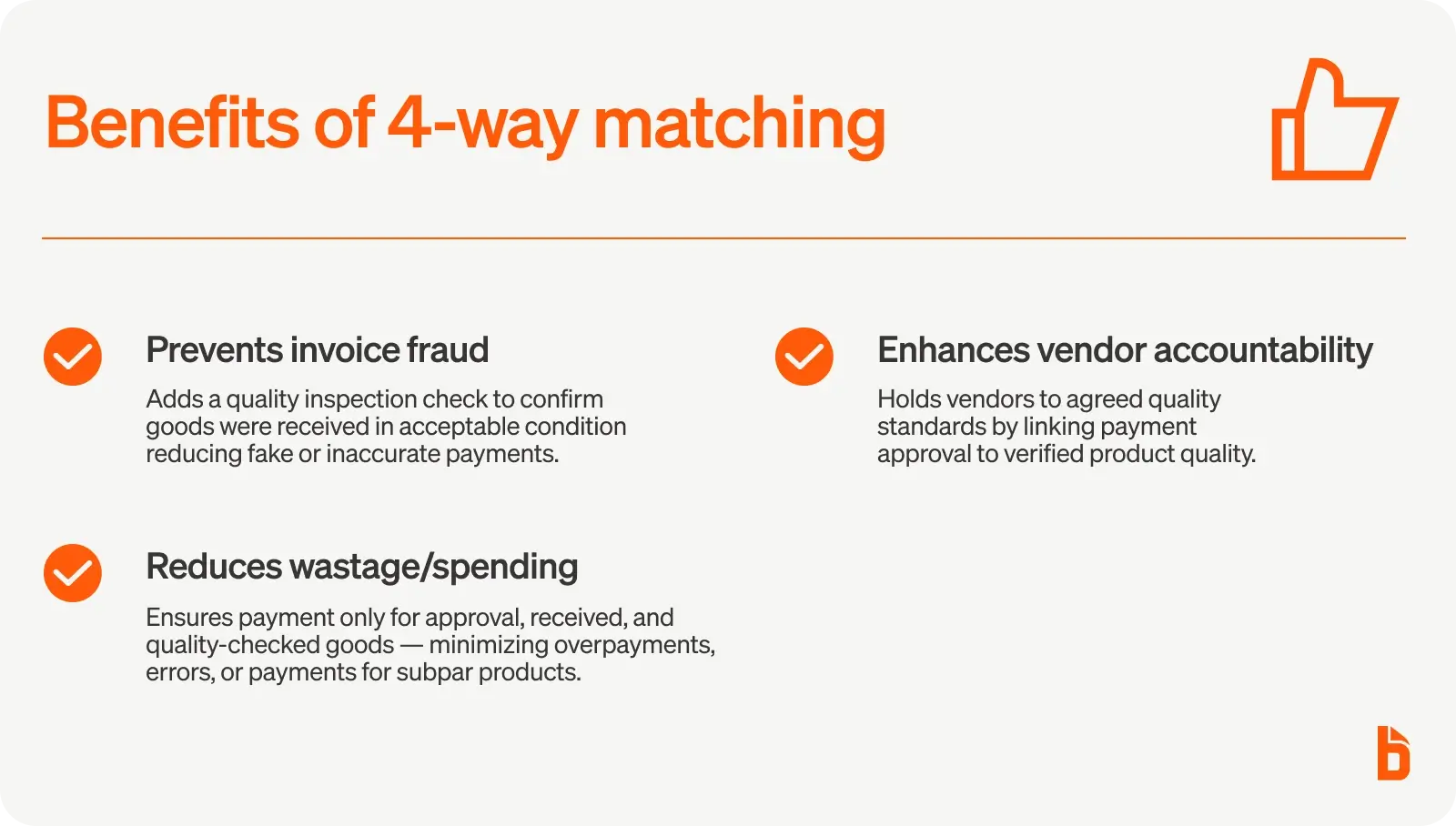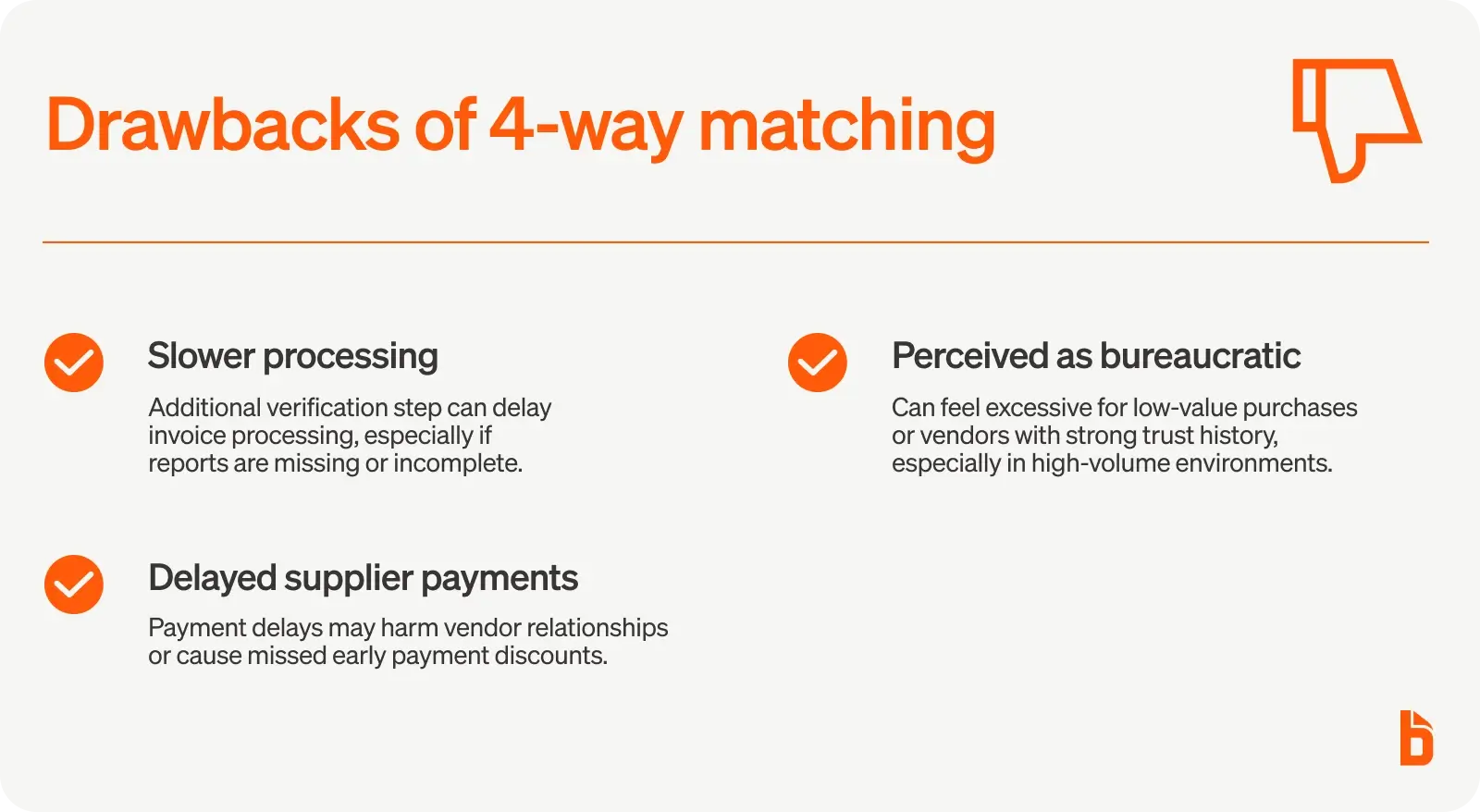One of the most important responsibilities of any accounts payable team is to ensure that the policies and procedures they employ not only protect the organization but maximize productivity and reduce barriers to working effectively.
It’s a delicate balance, and it often means having to decide between more robust practices that maximize security at the expense of efficiency or vice versa.
One such decision you’ll need to make is whether or not to employ 4-way matching.
Four-way matching is an invoice matching process and is an alternative to 2-way or 3-way matching.
Compared to its counterparts, it is more robust and offers greater security against invoice fraud, but it is also more time-consuming and may even be overkill in some situations.
In this article, we’re going to help you decide whether or not 4-way matching is the right move for your AP team.
What is 4-way matching?
Four-way matching is the process of comparing the purchase order, invoice, goods receipt, and quality inspection report to make sure they match, prior to approving the invoice.
It's designed to help reduce invoice fraud and provide greater assurance to accounts payable teams that they are paying the correct amounts to the right vendors.

How does the 4-way matching process work?
To action a 4-way matching process, follow these steps:
- Confirm that the invoice in question hasn’t already been paid
- Identify the purchase order number included on the invoice
- Pull up the PO and confirm that the vendor, goods or services, and amounts match
- Match the invoice against a goods received note (GRN) to confirm that the items actually received match what was ordered and invoiced for
- Check the quality inspection report and confirm that the goods were received in a condition that aligns with your vendor agreement
If, at any point during this process, an issue is identified, the process is paused until it can be rectified.
For example, if there is a discrepancy between the purchase order details and the invoice, then accounts payable will need to take this up with the vendor, the procurement team, or both.
How does 4-way matching fit into invoice processing?
Four-way matching, should you choose to use it, is stage two in the invoice processing workflow:
- Invoice capture and validation
- Invoice matching and purchase order verification *
- Invoice approval process
- Invoice payment process
- Documentation for audits
Four-way matching vs 3-way and 2-way matching
There are a couple of alternatives to 4-way matching:
- Two-way: Only requires the matching of an invoice against a purchase order.
- Three-way matching: Removes the need for a quality inspection report (i.e., matches the invoice against a purchase order and a GRN)

The tradeoff here is between security and efficiency.
Three-way matching gives you an additional level of security compared to 2-way matching, but it’s less efficient.
There are also diminishing returns to consider here.
That is, the most important match to make is between the invoice and the purchase order, confirming that what you’re paying for is what was ordered.
A goods received note is important, but less important than a PO match, with the quality inspection report arguably being the least important document of the four.
Your choice to use any of the three matching processes will come down to your desired position on the scale between security and efficiency.

Benefits of 4-way matching
Four-way matching can be beneficial for certain situations. Here are some of the most common reasons businesses choose it over two or three-way matching.
Helps prevent invoice fraud
The primary goal of any invoice matching process is to protect against the possibility of invoice fraud—that is, paying fake invoices that don’t relate to goods or services ordered or received.
A purchase order and GRN match go most of the way to preventing fraud.
However, including a quality inspection report check (the key difference in 4-way matching) helps you triple-check that someone in your organization has:
- Actually they laid their hands on the goods
- Confirmed that they not only exist but are exactly what you ordered in the condition you expected.
Reduces wastage and shadow spending
Four-way matching also helps you ensure you pay the right amounts to the correct vendors.
Matching the invoice against a PO ensures that you don’t pay any more (or less) than the procurement team approved.
Matching against a GRN ensures you don’t pay invoices for goods that were never actually received, a common form of wastage.
The final check (the quality inspection) makes sure that your vendors don’t get paid for sub-quality goods.
Improves your ability to hold vendors accountable to quality standards
The 4-way matching process also goes a long way to improving vendor relationships, enabling you to tackle potential issues related to quality or invoices as they arise.
Two-way and 3-way matching already help you make sure you pay vendors accurately and on time, which itself helps strengthen relationships.
The quality inspection component of the 4-way matching process helps you hold suppliers accountable to the quality standards set out in your vendor agreement, as you won’t approve payment until a quality issue has been suitably resolved.

Drawbacks of 4-way matching
While 4-way matching has its benefits, it's not the perfect solution for every scenario.
Like any accounts payable process, 4-way matching has some inherent drawbacks.
More time-consuming
Adding another layer of security checks inevitably means that your invoice processing timeframes increase.
The actual confirmation of the quality inspection report isn’t particularly time-consuming, though the time used adds up across hundreds of invoices.
More problematic, however, will be the need to chase up missing reports or resolve issues.
Can drag out supplier payments
If a 4-way matching process increases the length of time required to process an invoice, this can lead to a delay in payment to suppliers.
This could be due to no fault of their own, such as when the delay occurs because a quality inspection checklist goes missing or wasn’t completed.
It can also have a negative impact on spending if it means you miss an opportunity to secure an early payment discount.
Can be perceived as overly bureaucratic
4-way matching, being a more labor-intensive, security-focused, and time-consuming process, does run the risk of being perceived as being overly bureaucratic or serving as unnecessary red tape.
This is especially true if 4-way matching is required for all supplier payments.
For an organization approving millions of dollars in payments a month, a 4-way match for a $50 invoice might well be overkill.
When is it appropriate to use 4-way matching?
It’s ultimately down to your organization and its internal AP policies as to whether 4-way matching is an appropriate process.
More risk-averse and security-conscious organizations will lean toward embracing it. Those who are more interested in operational efficiency will likely prefer 2-way or 3-way matching for simplicity.
Generally speaking, the best solution is to find a middle-ground, setting specific policies for the use of different invoice matching techniques based on specific invoice characteristics, such as:
- Invoice value—e.g., Requiring 3-way matching for all invoices, with only those above $10,000 in value requiring a 4-way matching
- Vendor—e.g., an approved list of vendors only requires 2 or 3-way matching, while non-approved vendors must use 4-way matching
- Spend category—e.g., a restaurant chain might require 4-way matching for fresh produce (where quality control is critical) but not for office supplies (where a 3-way match might be considered sufficient)
Can 4-way matching be automated?
Accounts payable automation is an incredibly powerful tool for AP teams and one that can be leveraged to speed up the 4-way matching process.
Using automation to take care of certain aspects of the 4-way matching process—such as the matching of the invoice to a purchase number—can allow you to take advantage of a more robust and secure process without increasing workload for the AP department,
For example, with BILL, you can automate both 2-way and 3-way matching.
That means if you choose to adopt 4-way matching, whether for all invoices or only for those that meet specific requirements, you’ll only need to manually confirm the invoice in question against a quality inspection checklist.
Make invoice matching seamless with BILL
Invoice matching, whether 2-way, 3-way, or 4-way, is an important part of the invoice processing and payment workflow.
Compared to its counterparts, 4-way matching is a more secure process providing greater protection against invoice fraud, but it brings with it the drawback of being a more time-consuming and arduous process.
But with BILL’s AP system, you can automate away much of the manual work required to perform a 4-way match.
In fact, our customers spend, on average, 50% less time on AP processes like invoice matching using BILL.


